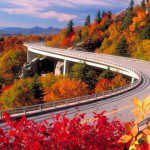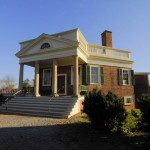The Blue Ridge, an Autumnal Escape in Virginia
By • August 15, 2013 0 1568

“We need the tonic of wildness,” wrote Henry David Thoreau. “We need to witness our own limits transgressed, and some life pasturing freely where we never wander.”
Since its publication over a century and a half ago, Thoreau’s novel “Walden” has become a seminal manifesto for naturalists and admirers of wildlife, as well as philosophers, poets, artists and wandering spirits. Living in a sparse cabin in the woods and enfolding himself within the untamed wilderness, Thoreau painted an unprecedented portrait of spiritual discovery through nature, one that is still called upon to inspire us to preserve, protect, and adore the sweeping, rapturous beauty of the American landscape. He makes a case for solitude, observation, and consideration, asking we look inside of ourselves to find the beauty that surrounds us.
I return to passages of this book frequently, usually when autumn starts rolling in and the warm daylight of late summer starts giving in to gusts of evening chill. The changing of the season reinvigorates my sense of the natural world—perhaps it is the anticipation of the beauty of changing leaves, perhaps the eagerness to come out of hiding from the August heat. There is a clarity and crispness about fall that wipes clean the slate of our spirits and offers a fresh perspective. And during this time of year, no area better captures the spirit of the swelling season like the sprawling, endless Blue Ridge Mountains.
Around every bend of the Blue Ridge Parkway, we come face to face with natural splendors, historic landmarks, cultural heritage, and timeless beauty. Starting at Skyline Drive in Front Royal, VA., (just an hour outside Washington) and winding down to Great Smoky Mountains National Park on the North Carolina border in Tennessee, this network of mountain roads holds within its graveled palms all the secrets, spells and quiet adventures that Thoreau has long implored us to share with him—with a few added luxuries and amenities that he probably never considered.
Whether embarking on a quick weekend getaway or taking a week off to explore autumn’s ephemeral bounty, there are worlds to explore in the Blue Ridge. From wineries, restaurants and B&Bs, to art centers, historic sites and heartbreaking overlooks, the perfect season is fast approaching to appreciate this hidden treasure of the East Coast.
To pull a word of advice from Mr. Thoreau once more: “Live in each season as it passes; breathe the air, drink the drink, taste the fruit, and resign yourself to the influence of the earth.”
Live in it now, before it all disappears into the grey dawn of winter.
Come For The History
One of Thoreau’s greatest influences was Thomas Jefferson, and it’s easy to understand why. Jefferson’s genius and influence as a leader, a politician, an independent and original thinker and a downright American is impossible to overlook or encapsulate. He quite literally wrote the book on independence and the virtue and value of the individual. Jefferson was also a man of relentless curiosity – fascinated by the world around him, always learning from what he encountered.
The house and grounds he built at Poplar Forest for his retirement, just outside of Lynchburg, VA, was a private, personal retreat, where he was free to indulge in his favorite pastimes of reading, studying and thinking. Today, the preserved estate is one of this country’s true hidden gems. The culmination of many of Jefferson’s long-incubated philosophies of life, Poplar Forest became a canvas on which he designed and built his most personal landscape and architectural creation. It was a place where he came to find rest and leisure, rekindle his creativity and enjoy time with his family.
Witness meticulous historic restoration in progress at the house Jefferson considered his best design for the life of a private citizen. Tours of the house offer the chance to learn about the estate’s architecture, preservation, and life in the early 19th century. Discover Jefferson’s vision for his gardens, ornamental plantings, and farm. There are also special events, including musical performances, historical theater, and lectures centered around the private genius of this American icon.
At Poplar Forest, visitors are offered not only a peak into Jefferson’s life, but into his mind and private world. A visit to Poplar Forest will deepen your understanding of Thomas Jefferson, as here he focused on his personal pursuit of happiness.
If you’re looking for a bridge between history and the great outdoors, The Natural Bridge, less than an hour down the road from Poplar Forest, might just do the trick. Equal distance from Charlottesville and Roanoke, VA, this bridge of solid limestone rock is a National Historic Landmark and twenty stories of sheer natural wonder.
After hiking to the top, the adventurous among us can descend 34 stories to explore the deepest caverns on the East Coast. A serene nature trail takes you through the great stone archway and alongside the Cedar Creek, and then down to the spectacular Lace Falls.
For those with less of an itch for adrenaline but an equally unquenchable interest, the exotic indoor butterfly garden offers a unique opportunity to experience an array of these delicate natural beauties.
In an oddly befitting twist of fate, the Natural Bridge was once owned by Thomas Jefferson—it was also surveyed by a young George Washington and traversed by Civil War soldiers. It is a true portal to history. For more information visit www.PoplarForest.org
Wine, Dine & Stay the Night
When combing through over 500 miles of historic roads and highways, resplendent with rich and vibrant communities and lush farmlands, there are going to be more opportunities to eat, drink and relax than to shake a stick at. However, there are a few undoubted highlights, both near and far from the Washington area.
For those who want to keep within relative proximity to the District, Barboursville Vineyard lies north of Charlottesville, VA , on the outskirts of the Blue Ridge Mountain range. If you’re embarking on a longer trip, it’s a great stop en route to more distant Blue Ridge territories.
The centerpiece of Barboursville is their tasting room, built in the style of a Northern Italian farmhouse that greets guests with a roaring double-sided fireplace during the colder months. Here you can sample the vineyard’s award winning wines, peruse books on all things viticultural, or relax at a table or on lawns overlooking the vineyards and the Blue Ridge with a bottle of wine. Their winery guides free weekend tours that takes guests around the vineyards and reveals the rich history of the Barboursville estate.
Palladio Restaurant is the estate’s restaurant, the culinary expression of the vineyard and the region, with Northern Italian influences that reveal a rooted culinary sophistication. Their sweet potato gnocchi with apple-pecan slaw is not to be missed. Enjoy a regular lunch or dinner, or reserve a wine dinner or cooking class, and get a backstage pass to the art of food and wine pairing, with an unmistakable local flare.
There are dozens of places to stay around the area—Barboursville is just a hop, skip and jump from Charlottesville. If you want the full accommodation and dining experience, The Boar’s Head Inn resort is a great choice, as well ask Keswick Hall and the Cedar Springs Inn & Spa. For more information, visit www.BarboursvilleWine.net
If you’re in it for the longer drive, Banner Elk Winery & Villa is perhaps the quintessential Blue Ridge getaway. In the far west of North Carolina, almost by the Tennessee borderline, Banner Elk is nestled far into the mountains, and a stay at their intimate villa might just give you the refreshing taste of wilderness you seek. Awaken to the cricks, whistles and willowy swoons of nature, followed by breakfast on the veranda.
Their Farm to Table dinners begin with a glass of wine and a nibble from the vineyard kitchen, followed by a stroll through the kitchen garden where the season’s offerings are explored, and a peek into the barrel room that offers a brief overview of their winemaking process. Kitchen ingredients change seasonally and are grown and sourced locally, either on the grounds of Banner Elk or from local farmers. For more information, visit www.BannerElkWinery.com
The Arts of the Blue Ridge
From bluegrass music and folk art, to time honored carving and furniture-making traditions, there’s no shortage of artisanship in and around the Blue Ridge. The Blue Ridge Music Center celebrates the music and musicians of its past and present, established by Congress in 1985. The site includes an outdoor amphitheater and indoor interpretive center used to highlight an important strand of American musical culture, which is still alive and thriving in the region.
Located in historic Galax, VA , long revered for its regional musical heritage, the Center brings visitors into the traditions of ancient fiddle and banjo traditions of Virginia and North Carolina, music that can be traced to the meeting of the African banjo and the European fiddle in the Tidewater before the founding of our country.
The Center’s concert series, performance-talks and new exhibition, The Roots of American Music, trace the history of this regional music through local artists back to the creation of the music generations ago by Europeans and West Africans, showing how it continues to influence many forms of folk and popular music made across America today. The music performed is from today’s revered keepers of the Appalachian music tradition, like the duos Bill and Maggie Anderson, and Bobby Patterson and Willard Gayheart. For more information, visit www.BlueRidgeMusicCenter.org
Located five minutes from downtown Asheville, N.C., the Southern Highland Craft Guild and Folk Art Center brings together the crafts and artistic traditions of early America to a contemporary venue for all to explore. The dynamic and multifaceted center showcases the finest in traditional and contemporary crafts of the Southern Appalachians, housing three galleries, a library and craft shop that host events and exhibits throughout the year.
The Southern Highland Craft Guild, chartered in 1930, is one of the strongest craft organizations in the country, representing close to 1,000 craftspeople in nearly 300 counties throughout nine southeastern states. For more than 80 years, the Guild has been bringing together the crafts and craftspeople of the Southern Highlands to educate and preserve these historic traditions, and now hosts five craft shops, regular educational programming and two annual craft expositions.
From Oct. 18 – 21, you can experience this unique tradition at the 65th annual Craft Fair of the Southern Highlands. From stone and wood carving, blacksmithing and wheel thrown pottery, to ancient yarn spinning techniques using natural plant dyes, the festival is, rather fittingly, one for the ages. For more information, visit www.SouthernHighlandGuild.org
Foliage Watching and Skyline Drive
During the month of October, usually mid-to-late month, the autumn foliage reaches its peak radiance, changing first on the highest peaks and working down to lower elevations. It’s really impossible to predict how and when the leaves will change each year—there’s no simple formula to it and there are many determining natural factors—but the best plan of action is to pick a day and start driving down the Blue Ridge Parkway. (Another tip: go on a weekday, even if you have to take a day off work. On weekends during peak foliage, the Parkway can turn into a near parking lot.)
Perhaps the most scenic and breathtaking route is Skyline Drive. A 100-mile stretch of mountain road that runs the entire length of the Shenandoah National Park, beginning in Front Royal, VA., on the north end, no other highway carries the zeal and sweep of the rolling Blue Ridge landscape quite like Skyline Drive. Around every bend you are met with picture-perfect, draw dropping overlooks. It is almost a requirement to have two passengers in every vehicle: one to drive, and one to take photographs. There are also plenty of scenic overlooks and turnoffs that offer opportunity to step out and really soak in fall’s transient splendor.
The reminder of nature’s grace and beauty is truly the greatness of the fall season. Take a tip from Thoreau and don’t let it pass by you.
- Banner Elk Winery
- Blue Ridge Parkway
- Blue Ridge Parkway
- Poplar Forest





